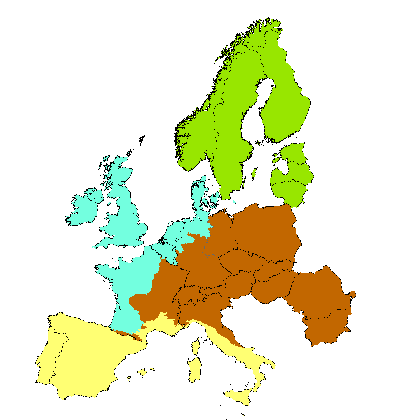Species selection and classification
To produce common bird indicators, species that are to be included have to be selected and classified according to habitat types in Europe.
So far, three versions of our PECBMS European species selection/classification have been produced and used. Initially based on expert judgment and comprising only a limited number of species, the procedure has developed to a more formal classification of species at the level of bio-geographical regions. More than 100 species are nowadays used to produce indicators.
The first set of European indicators was based on 47 common bird species. They were classified by the national coordinators of monitoring schemes and other experts who met at the PECBMS workshop in Prague in 2002 (read the report in the Bird Census News 16/1). The second set of European indicators comprised an enlarged species set, classified according to the publication by Tucker & Evans (1997). Since 2007, when we produced the third set of European indicators, the species classification is based on assessments within bio-geographical regions in Europe, as described below.
The recommendation to classify species at the biogeographical regions in Europe comes from a PECBMS mini-workshop held in March 2005 in Lednice, Czech Republic. It would take into account that birds do slightly different things in different places. For instance, a bird species that is considered a forest species in one region may qualify as a generalist species elsewhere. Also, it would make better use of local expertise.
The procedure initiated in Lednice was approved and developed further at the PECBMS workshop in Prague, Czech Republic, in September 2005 (read the report in the Bird Census News 19/1). Regional coordinators, responsible for regional species lists in cooperation with all relevant experts within their regions, were appointed, and a schedule was approved. Distinguished regions were: ´Continental´, ´Atlantic´, ´Mediterranean´, and ´Boreal´.
The bio-geographical regions were used solely for species habitat classification, not for the imputation of missing values when computing supranational population indices, where geographical regions were used instead.

Explanations:
[blue] ´Atlantic´: Belgium, Denmark, France Atlantic (Atlantic part of the country), West Germany Atlantic (Atlantic part of the country), Ireland, Luxembourg, Netherlands, UK.
[yellow] ´The Mediterranean´: France Mediterranean (Mediterranean part of the country), Italy Mediterranean (Mediterranean part of the country), Spain, Portugal.
[brown] ´Continental´ (incl. Pannonian region): Austria, Czech Republic, East Germany, West Germany Continental (Continental part of the country), France Continental (Continental part of the country), Hungary, Italy Continental (Continental part of the country), Poland, Switzerland, Romania, Bulgaria, Slovakia.
[green] ´Boreal´: Estonia, Finland, Latvia, Lithuania, Norway, Sweden.
As we are focusing on common birds, abundant and widespread species are to be used preferably. Species with > 50 000 breeding pairs in ´PECBMS Europe´* are considered to be widespread. However, we could add other species, too. These are species that are not well covered by generic monitoring schemes, the main PECBMS data source. Such species are difficult to detect by generic schemes because of their biology, for example, those with nocturnal activity (e.g. owls), some colonial species, or scarce species. We would need data from species-specific monitoring schemes. However, this is currently out of the scope and capacity of PECBMS.
Non-native species are excluded, being an unnatural component that doesn´t contribute to the avifauna quality.
The species selected were classified into characteristic farmland species, characteristic forest species, and other species. We classified them according to their predominant regional habitat use – farmland, forest, other: the percentage of the regional population that uses farmland/forest for breeding or feeding (0-25; 25-50; 50-75, >75; the situation in 2000). Any links with a driving force were indicated.
Then, we checked if the species selected are sufficiently abundant in the regions, compared species selection and classification between regions compiled a final species list and circulated it to national coordinators for discussion and approval.
Finally, regional species classifications were combined into the PECBMS European species classification. For this general classification, a species was assigned to a particular habitat category if:
- at least two regions provided their classification, and all providing regions agreed, or
- only one region (minority) classified a species different from the others.
In some cases, a species classification was provided by one region only. Still, if the species were concentrated in that region and didn´t occur elsewhere in Europe, the species regional classification was accepted as European.
If regional classifications differed completely, a species was considered as ´other species´.
The final list of species and their classification can be downloaded.
* ´PECBMS Europe´ is EU 26 (excluding Malta) + the UK, Norway and Switzerland and consists of those countries which already deliver their data to PECBMS: Andorra, Austria, Belgium, Bulgaria, Croatia, Cyprus, Czech Republic, Denmark, Estonia, Finland, France, Germany, Greece, Hungary, Italy, Latvia, Lithuania, Luxembourg, Netherlands, Norway, Poland, Portugal, Republic of Ireland, Romania, Slovakia, Slovenia, Spain, Sweden, Switzerland, the United Kingdom.
However, some parts of these countries (states) were excluded, mainly because of their far distance to the mainland of Europe: the Faroe Islands and Greenland, Svalbard, Azores, Madeira, Canary Islands, Gibraltar.